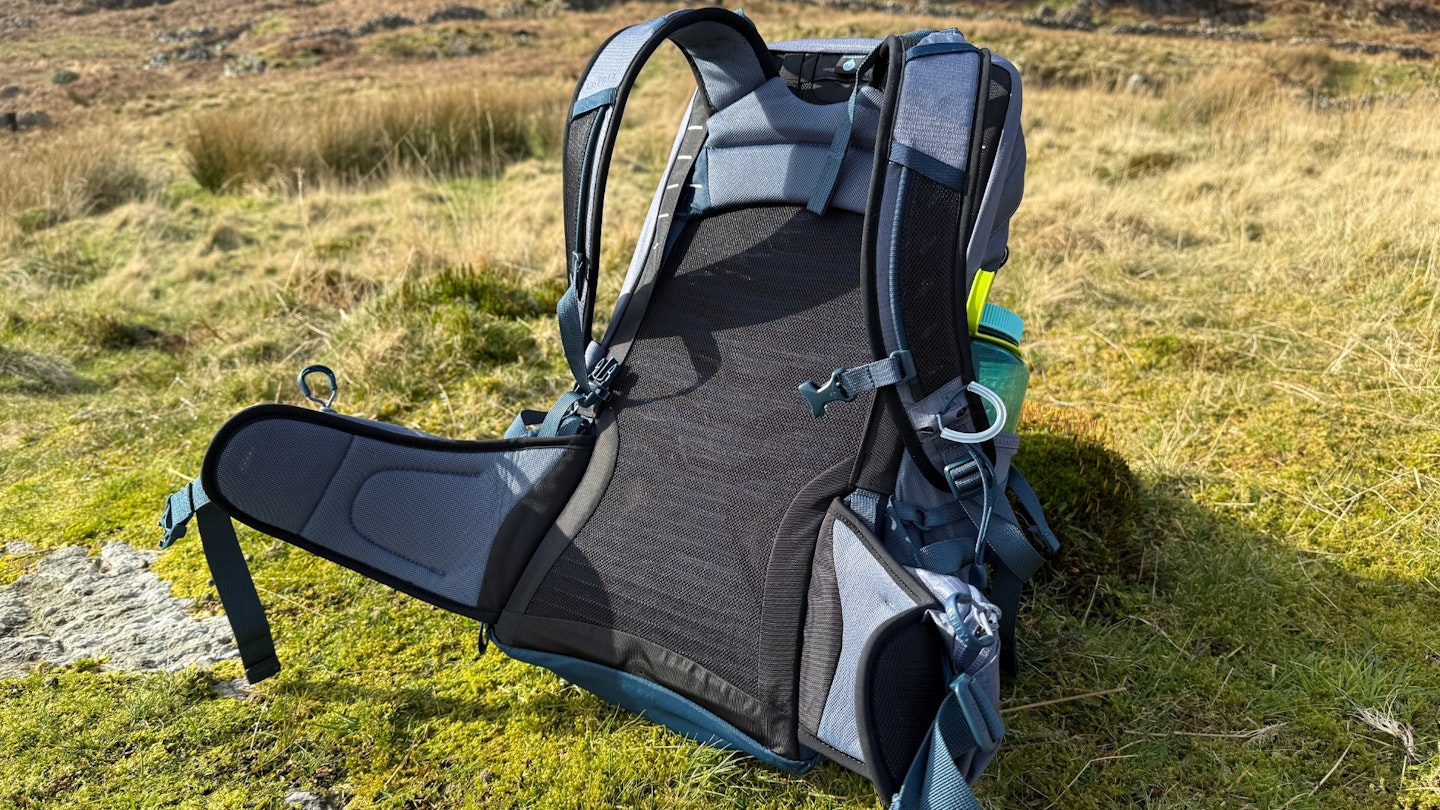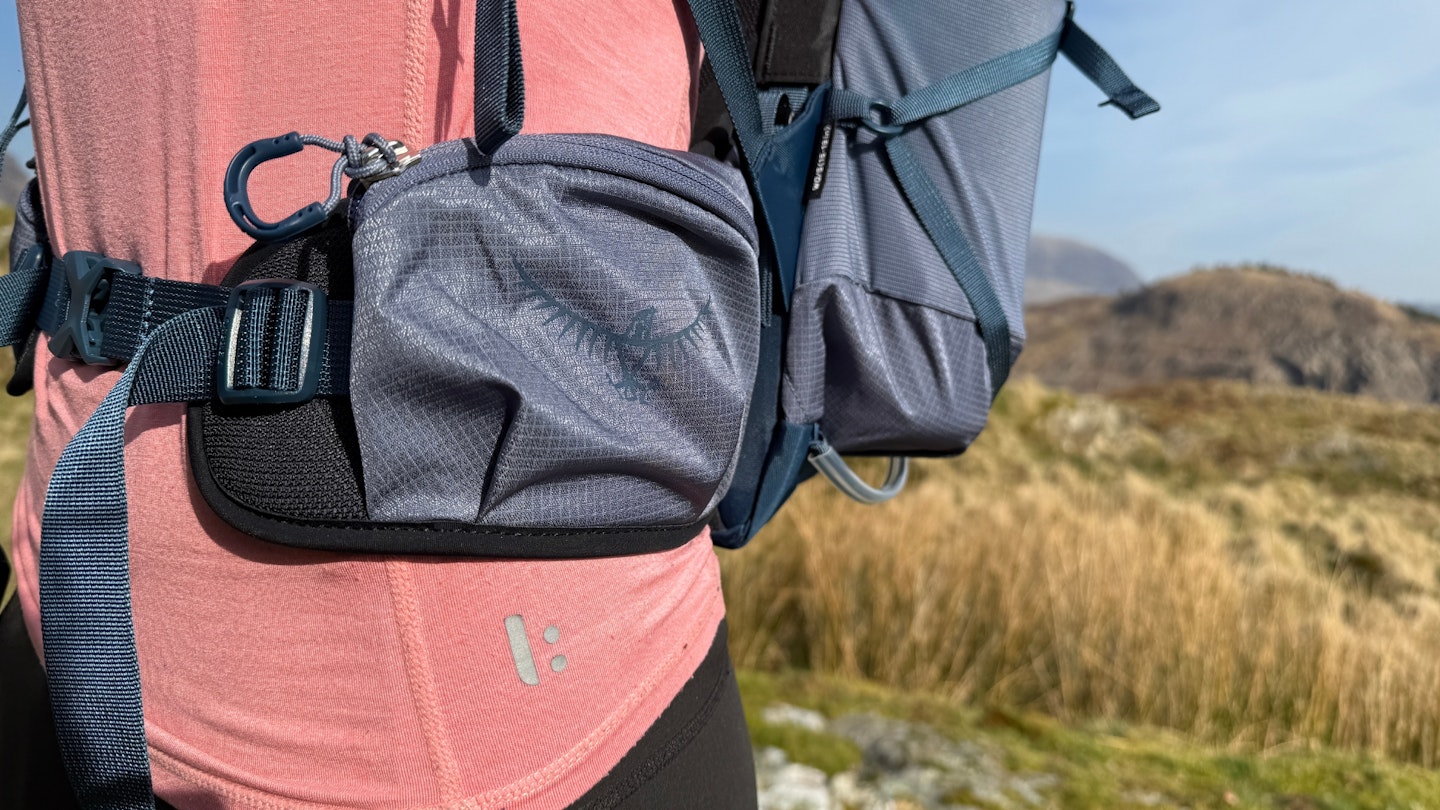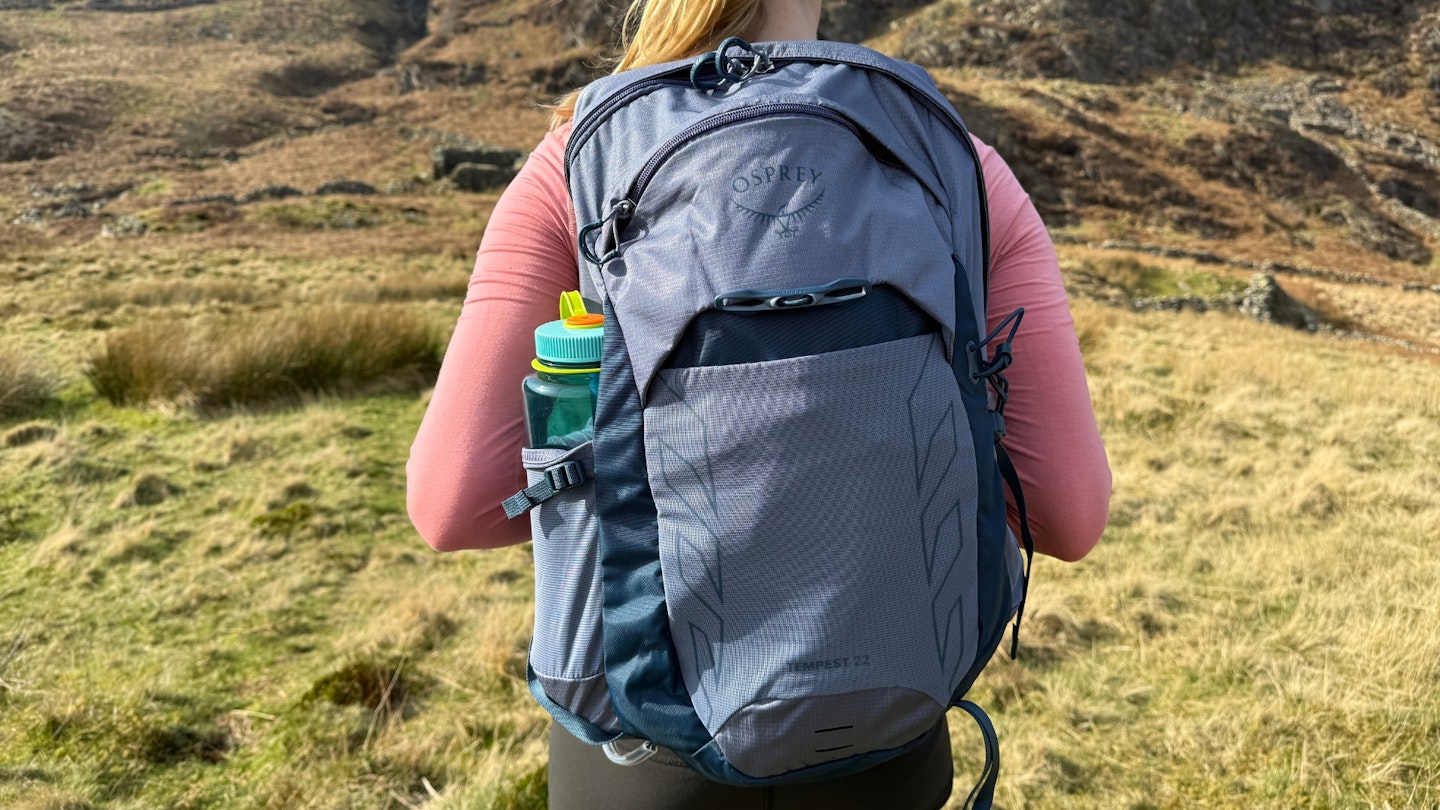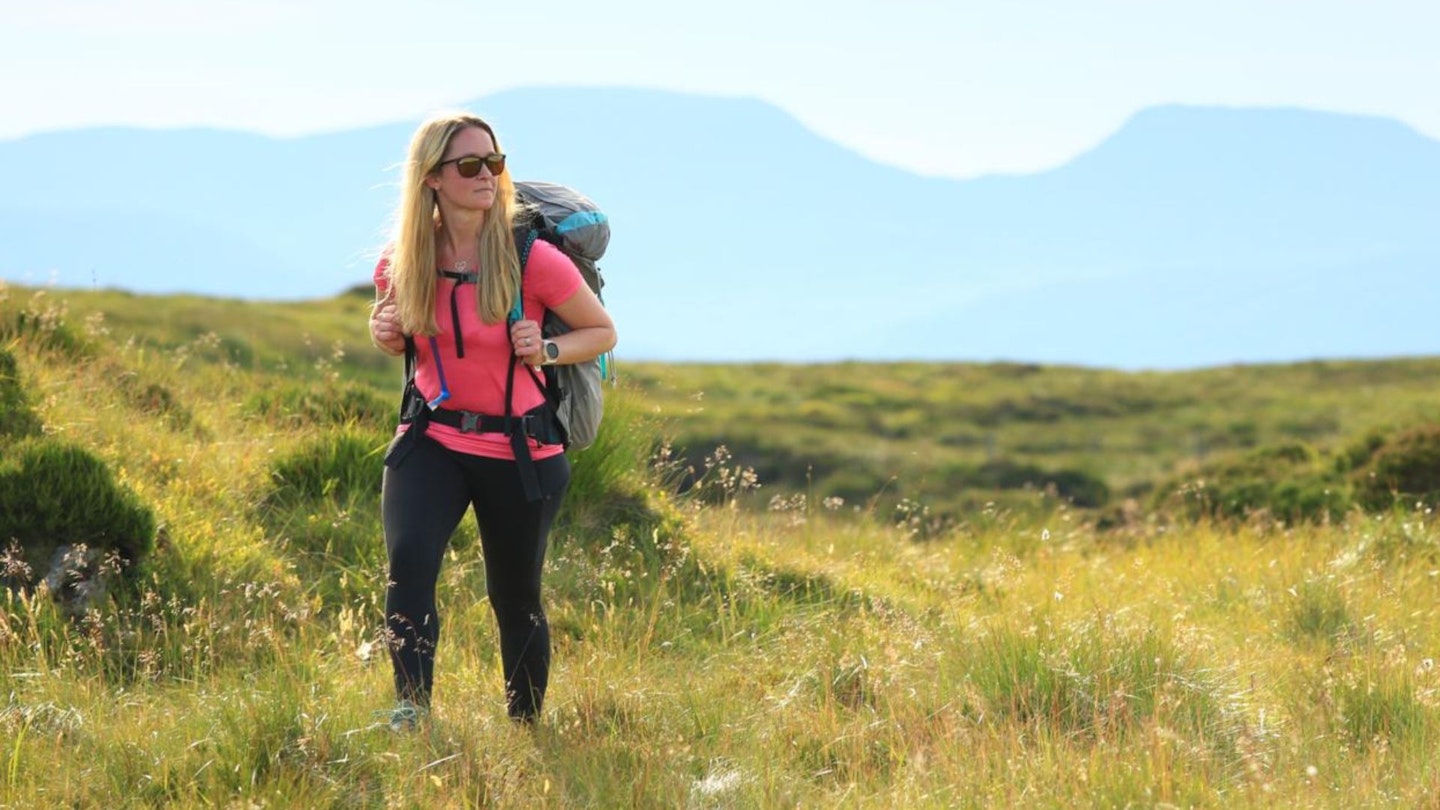The women’s-focused Tempest (or men’s Talon) is arguably Osprey’s most versatile technical pack series (and one of its best daypacks), which perhaps accounts for its enduring popularity. It’s a stalwart of the US brand’s extensive product range, and as well as being a familiar sight on the hills, you’ll also find it on the backs of bikers and skiers alike.
It comes in a range of sizes, from a small 6-litre waist pack up to a 44-litre gear hauler. The Tempest 22 sits slap bang in the middle of the range.
It’s a classic mid-size women’s hiking daypack ideally suited to warm-weather hikes. It’s big enough to carry the basics you’d need for any walk anywhere: waterproofs, warm layer, first aid kit, lunch and snacks, water bottle, walking poles and other small essentials (map, compass, head torch, phone etc).
An abundance of storage compartments and pockets helps to keep such items efficiently organised and close to hand.
Pros
- Adjustable fit
- Versatile
- Great features
- Good sustainability credentials
Cons
- Too fussy for those who prefer a minimalist pack
- Not the lightest
- Not as well-ventilated as a suspended back system
- No raincover
| RRP: | £125 / $160 |
| Weight: | 1.03kg / 2lb 4oz |
| Volume: | 22 litres (1342 cu. in.) |
| Sizes: | Standard (adjustable back length from 15 to 19 inches) or extended fit |
Upgrades to the latest model have been made with ergonomics in mind. These include a BioStretch harness, continuous-wrap hip belt and an injection-moulded, die-cut foam AirScape back panel, all of which are designed to move with you.
The slight redesign to the women’s packs has also increased their capacity slightly. Previously, most of the Tempest packs were two litres smaller than the men’s Talons, which always seemed a little incongruous. Happily, the packs have been rationalised so there are now direct equivalents throughout the range.
Back system

For a relatively compact pack, the harness and back system of the Tempest 22 is fairly sophisticated. This makes it particularly well-suited to demanding day-hikes, including mountain walks.
The most noticeable feature is the AirScape back panel, which is made of injection-moulded, die-cut foam with integrated air channels, overlaid by light mesh. This keeps the load close to your body for stability, while still providing sufficient ventilation to mostly ward off a damp, sweaty back.
The only negative is that we wish it was a little more sculpted to mimic the curvature of your spine. The panel is slightly contoured, but still relatively flat, so it doesn’t hug the body quite as well as some rivals. On the other hand, this makes for easier loading.
It’s a simpler system than Osprey’s other core day-hiking packs – the Stratos for men and Sirrus for women (a Trail Gear of the Year winner) – in which the load is held away from your back by a concave, suspended system called AirSpeed, which creates a wide, curved space for maximum airflow.
These types of ‘trampoline’-style back panels are generally a better choice for the warmest, stickiest days. But the curved design does tend to obstruct the main compartment slightly, making packing more awkward. Secondly, some hikers feel that a suspended system affects their centre of gravity, and thus their balance, especially if they like scrambling or moving quickly.
The Tempest has neither of those disadvantages, so if you like an easy-loading pack with a very stable and balanced feel, then the Tempest’s AirScape back system may work better for you.
It’s also worth noting that the Tempest 22 is £30 cheaper than the comparable Sirrus 24 (£125 vs £155), as well as being a bit lighter overall.
In terms of sizing, the Tempest 22 is available in a standard size with an easy-to-use torso adjustment system to fit back lengths from 15-19in (38-48cm). Unlike the ladder-style adjustment of the Sirrus packs or the Velcro adjustment of the previous generation Talon/Tempest, it now uses a clever slider, which is directly attached to the perimeter wire frame of the pack itself.
By tensioning the load lifters and two buckles positioned just above the hip fins, you can move the harness to multiple positions as desired. It’s neat, simple and effective.
In 2022, Osprey also launched an Extended Fit range for plus-size walkers. There are now Extended Fit models of both the women’s Tempest 22 and 33-litre packs (as well as the same sizes in the men’s Talon packs), which are designed to fit up to 70-inch hips. This is a laudable move. It’s just a shame they only come in black.
Harness and hip belt

The Tempest’s harness and hip-belt together form a system that Osprey calls BioStretch. Essentially, the lumbar section, hip-belt and back panel all merge together with no gaps or bumps, ensuring the whole assembly wraps snugly round your hips and lower back. It feels great and minimises the risk of rubbing, chafing or hot spots.
The hip-fins are wide and well sculpted, but only lightly padded, which isn’t really an issue on a mid-size pack, where you’re unlikely to be carrying big loads.
The lightweight build also ensures they offer good support without getting too warm. And there are still two zippered pockets on each hip fin, giving you useful easy-access storage.
Each fits an iPhone 16 Pro smartphone. The hip belt fastens with a central plastic side-release buckle and adjusts easily with a simple pull on each side.
Shoulder straps are also lightly padded with perforated ventilation holes and mesh overlays. It strikes a good balance between weight-bearing strength, overall comfort and breathability. A sliding chest strap makes adjustment easy yet stays firmly in place without slipping. The buckle has a built-in safety whistle too.
Design and features

The Tempest 22 has a perimeter wire frame and stiffened frame sheet for rigidity, ensuring plenty of load-carrying grunt for a mid-size pack. This also ensures it stands up on its own when placed on the ground and gives the pack a rectangular profile that is a practical shape for loading.
Access to the main compartment is via a large, two-way zipper. This opens wide for easy rummaging and isn’t obstructed by side compression straps, which is often a bugbear with many zippered daypacks.
Otherwise, pretty much every feature you could want in a daypack is here. Inside the main compartment you get a hydration sleeve and central exit port for a water bladder – though the hanging tab is designed for use with Osprey’s own Hydraulics reservoirs and doesn’t work so well with rival systems. There’s a zippered inner mesh pocket with a key clip too.
Externally, there are two deep stretch side pockets for water bottles, plus a front stretch shove pocket for stashing waterproofs or other layers. Above this, you get another roomy zippered storage compartment. Dual side compression strap can be used to cinch in the load.
There are also attachment points for trekking poles, a bike light clip and even a helmet holder using Osprey’s clever LidLock system. You also get ‘stow-on-the-go’ trekking pole loops, which secures your poles at the left shoulder strap and the base of the pack, meaning you can stash them without taking the pack off.
Another nice design tough is that the zip pullers are all fitted with large, sturdy rubber loops – no problem to use with cold hands or gloves on.
The only real omissions are weather protection. There is a DWR coating on the fabric, but no rain cover included (unlike its stablemate, the Sirrus 24).
Similarly, the zips are housed beneath fabric storm flaps, but these aren’t much protection against much more than drizzle. If you know the day ahead will bring rain, it’s best to use a rucksack liner or stash your kit in dry bags.
Overall dimensions are about average for a day-hiking pack: 51cm height x 29cm width x 29cm depth. It’s slightly taller and deeper than the old Tempest 20, but still nice and narrow, so it doesn’t impede arm movements, especially if scrambling.
At 1.03kg empty, it’s not the lightest day-pack – but it’s by no means the heaviest either. The weight is understandable given the multitude of on-board features and the adjustable back system.
It's a slick and well-designed pack. Pretty much everything is where is should be and it all works. The worst you can say is that the pack may be too fussy for those who prefer a more stripped-back, minimalist hiking pack.
On test, Ellie took it on numerous spring day hikes in the mountains of Eryri. Performance was superb: she found it moved easily with shoulders and hips, ventilated excess heat pretty well considering it’s not a suspended back system, and was able to stash every item in a sensible place.
Sustainability

Osprey has made big strides in terms of sustainability in recent years. This particular pack features a 100% recycled polypropylene framesheet; 87% recycled mesh back panel, harness, water bottle and shove-it pocket; and 50% recycled foam back panel and waist belt.
In addition, the main fabric is bluesign-approved, being made from 100% recycled 100D high-tenacity nylon w/ dobby check ripstop and finished with a PFAS-free durable water repellent treatment (DWR).
The base is made from a thicker and more durable 420D nylon that again is bluesign-approved, 100% recycled and finished with a PFAS-free DWR. And even the secondary fabrics used for the pocket linings are bluesign-approved, being made from 100% recycled 70D nylon, with a PFAS-free DWR.
Price and competition

The latest model of the Tempest 22 has an RRP of £125 ($160), which is actually £10 cheaper than last season’s Tempest 20. Bravo Osprey!
It’s still a premium pack, though, and you can of course get good daypacks of a similar size for a fair bit less. Good examples are the Mammut Lithium 25 (£105), the Deuter AC Lite 21 SL (£95) and the Berghaus Remote Hike 23 (£110), all of which come in women’s-specific fits.
Alternatively, if you’re not bothered about the extra comfort that usually comes with a dedicated gender-specific fit and/or are on a tight budget, you could also look at bona fide bargains like the unisex Highlander Venture 20 (£30), the Decathlon Quechua MH500 (£55), the new Vango Mitra Air 20 (£62.50), the Alpkit Presta 25 (£70) or the Sprayway Akka 30 (£75).
However, there are good reasons to bump the budget if you can and opt for the Tempest 22. It’s a very well-built pack with a versatile feature set that means you could use it for hiking, cycling and everyday carry.
If viewed as an investment that is likely to last and provide enduring comfort for many miles over many years, that £125 price tag becomes much easier to justify. Osprey also offers an impressive warranty that is renowned as one of the best in the business when it comes to looking after its customers.
Verdict

The Tempest 22 is a great pick as a women's backpack for hikers and hillwalkers, with a gender-specific fit and an adjustable back system. The design is versatile enough to work on low-level trails as well as in more challenging mountain environments, at least in the warmer, drier months.
It’s not the simplest or lightest pack around though, while the AirScape back panel lacks the supreme ventilation of a fully suspended system, like that found on its Osprey stablemate, the Sirrus 24. But as a versatile all-rounder, the Tempest 22 is still an excellent choice.
If you're looking for more carrying capacity, check out our full roundup of the best hiking backpacks.
Shop this product
About the author

Matt Jones is a freelance journalist based in the heart of Snowdonia National Park, he’s a vastly experienced gear tester and self-confessed outdoor kit geek.
Matt’s been one of our main gear testers for the last couple of years and is the first person we call with any complicated kit queries that need in-depth and forensic analysis.

Ellie lives and works in Eryri (Snowdonia), where she spends her time roaming the hills and putting kit through its paces. As a big fan of long-distance trails, she’s ticked a fair few off in the UK including the Pennine Way, Cambrian Way, West Highland Way and Great Glen Way. She’s also hiked in Iceland, the US, Hawaii and New Zealand.





